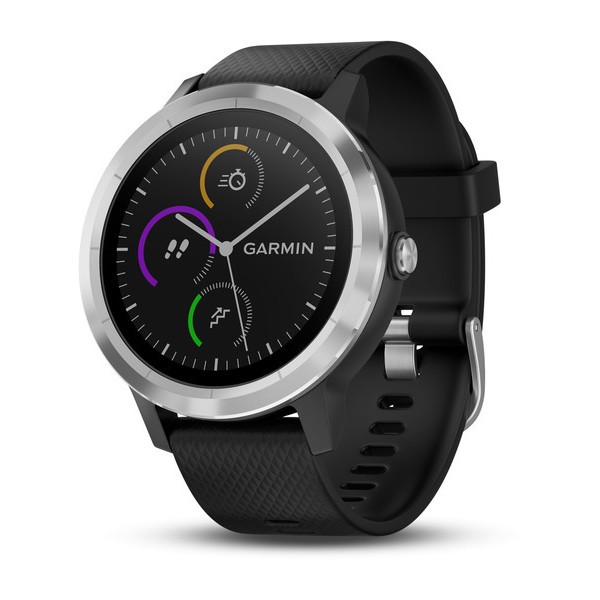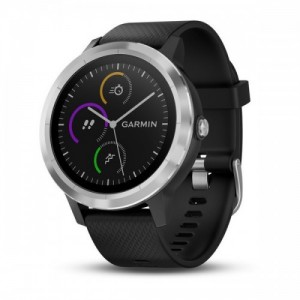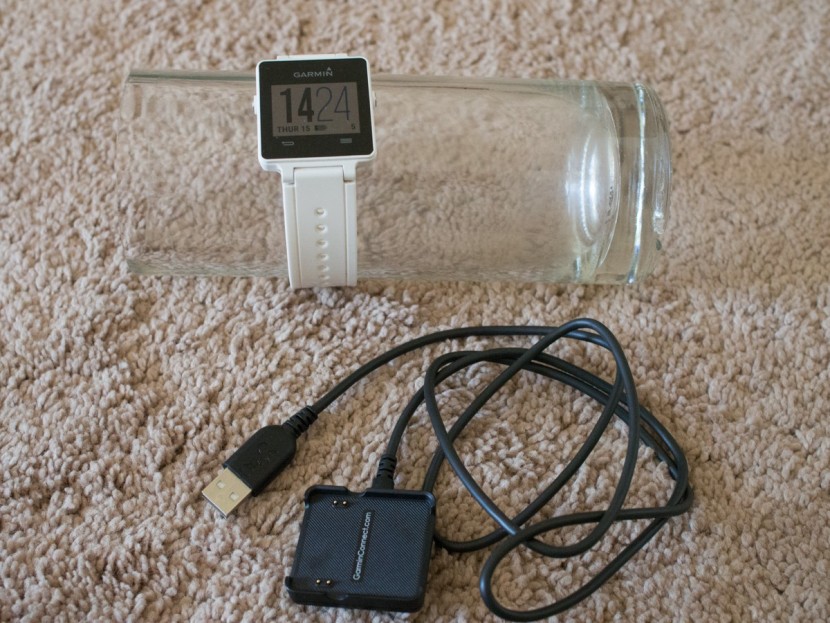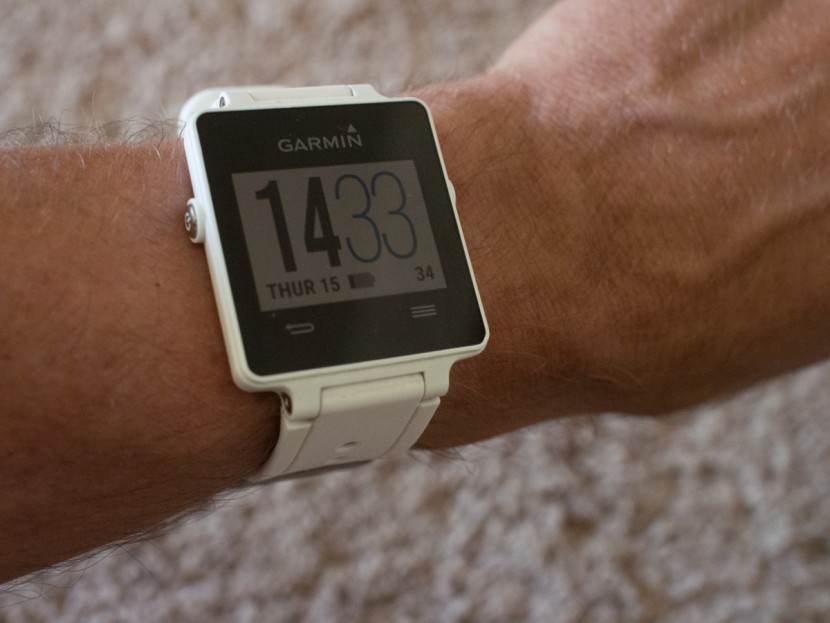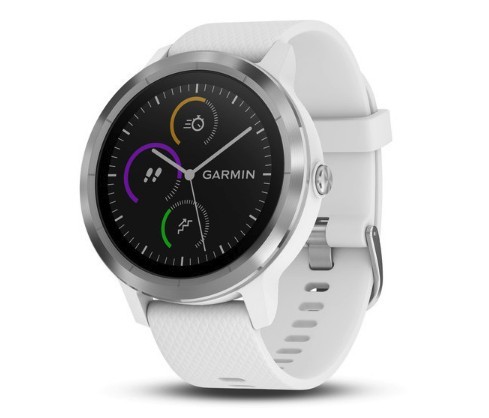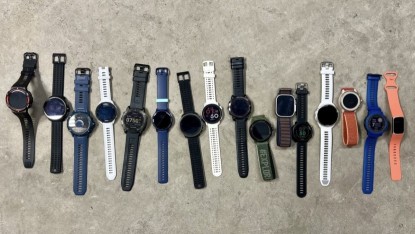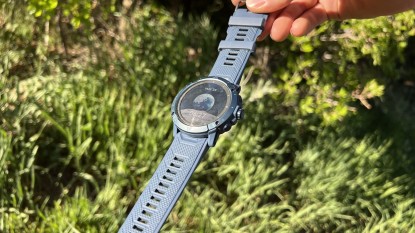Garmin released the Vivoactive 3 with major updates! Check out the info on the new watch below.
Garmin Vivoactive 3 Review
Our Verdict
Garmin released the Vivoactive 3 with major updates! Check out the info on the new watch below.
Our Analysis and Test Results
The New Vivoactive 3
Garmin completely redesigned the Vivoactive into the Vivoactive 3. This new version features an entirely different look (as noted below in the comparison photos, with the newer version shown on the left and version we tested on the right). The watch now features a heart rate monitor, the ability of load credit cards onto the watch, and a host of other options like a music player, stress tracking, and fitness level monitor apps.
Here is a brief summary of the updates to the new watch.
- Aesthetic Updates — The new watch, shown above on the left, features a circular watch face.
- Heart Rate Monitor — The Vivoactive 3 boasts a built-in wrist-based heart rate monitor.
- Garmin Pay — You can now load payment options such as debit and credit card numbers onto the watch so that you can make purchases without carrying your wallet along.
- New Features — The Vivoactive 3 comes with a whole host of new features not included on the original watch, such as a compass, barometric altimeter, gyroscope, and thermometer, to name a few. For an extra $30, you can get a version of the watch that holds and plays up to 500 songs.
The Vivoactive 3 retails for $270 without the music option, and $300 with music. Since we haven't tested the latest version yet, the rest of the text in this review refers to the version we tested, the Vivoactive.
Hands-On Review of the Vivoactive
The Garmin VivoActive melds the basic versions of three different devices into a package that should have wide appeal but doesn't score highly in any one category. It is a basic smartwatch, with simple GPS recording attributes, and it also works like an activity monitor to track daily steps and sleep patterns.
The VivoActive is not a top of the line product, nor is it a bargain. It is not comprehensive, but it omits very little from the full-service products. This contender is an excellent choice for both daily use and specific event tracking.
Ease of Use
Garmin has come a long way in terms of the ease of use of their products. They are a long-time contender in the general GPS market. As a big, older company in the field, they used to seem relatively slow-moving and late-to-adapt as compared to the rest of the field, especially among new “start-ups” that emphasized the slickness of their products' user interfaces. Garmin, especially with the VivoActive, has handily come “up to speed” and now offers a user experience that meets or exceeds that of the newer outfits. This model has a touchscreen, fast app sync, and an app interface that is intuitive yet comprehensive. Our only wish is that the device could be locked completely.
With a simpler set of features and functions, the VivoActive is inherently easier to use than the Editor's Choice Garmin Forerunner 935. They both use the same app, so that part is the same. On the device though, there are simply far fewer options on the VivoActive. The touchscreen is also unique to the VivoActive in this comparison. The on-device experience of the VivoActive is similar in intuitiveness and simplicity to the Fitbit Surge. The Ambit3 Peak is intuitive, but far more complicated overall. The electronics of the Polar m400 are slow, hindering that product's usability, while the Nixon Mission is clumsy and complicated, as compared to the Garmin.
Features
In some ways, the VivoActive has just the right feature set for broad appeal. One of our testers grabbed right ahold of this for over a month of the review, using it as her daily watch, activity monitor, and fitness tracker. For daily use, the Garmin is rivaled only by the Top Pick Apple Nike+. Clear time-keeping and simple, clean smartwatch attributes appeal for daily use. Seamless step counting and sleep monitoring make the VivoActive replace your dedicated activity tracker. Finally, the sport-specific GPS tracking (which, of course, is the reason we've reviewed it here) of the Garmin lets you use the same device for monitoring and recording your runs and bike rides. The VivoActive is a device that one can use 24/7. In dedicated sports tracking, there are compromises made with the VivoActive. There is no barometric altimeter for accurate altitude tracking in steep terrain, for instance. Also, the navigation feature is very basic. All you can do is navigate, within an exercise mode only, in a straight line back to where you started the exercise.
Regarding features, the Editor's Choice Garmin Forerunner 935 and its bulkier sibling, the Fenix 5, are at the top of the heap. These models have almost everything we could imagine in a GPS watch, with only a little room for improvement in smartwatch functionality. This, however, is the least important of the potential features in a product like this. In addition to what the VivoActive does, the Forerunner 935 and the Fenix 5 have extensive navigation options, barometric altimeters, and wrist-mounted optical heart rate tracking. The Top Pick Apple Watch also has more features than the VivoActive. It does all that the VivoActive does, plus wrist-top heart rate and extensive smartwatch features, including customizable app suites. The VivoActive has some features that the Best Buy Garmin Forerunner 35 doesn't (specifically, activity and sleep tracking) while the Forerunner has a heart rate sensor that the VivoActive does not. The VivoActive has a set of functions quite similar to those on both the Polar M400 and the Fitbit Surge. The Polar lacks smart watch attributes and adds an included heart rate band, and the Fitbit has wrist-top heart rate but no navigation potential.
Accuracy
Accuracy is the easiest to test, but perhaps the least important and least variable attribute we review. In our objective, repeatable track test, the VivoActive revealed just 1% variation from actual. We test all our GPS watches on a standardized running track for multiple laps. In this repeatable test, we found that the entire set of tested GPS watches varied from 0 to 7% error. In this range, then, the VivoActive is near the top of the heap. The VivoActive tied with the Suunto Ambit3 Peak and the Top Pick Apple Nike+.
Ease of Set-Up
This scoring metric continues to raise the bar. With the ubiquity of smartphones and Bluetooth receivers in these watches, set up is largely a breeze. What used to be a process that took hours, multiple button push sequences, and inevitable “do-overs” is now a matter of syncing the device with your phone and entering a few simple pieces of information. Electronics manufacturers have come a long way in this regard.
These GPS watches, especially those from the established companies, are largely easy and intuitive to set up. The VivoActive is no exception. Download the app, charge the device, and it'll walk you through the rest. The Apple Watch is the easiest to set up, but it requires an Apple phone. All the Garmin devices we tested work with all smartphones. The VivoActive is perhaps the device that most closely compares to the Top Pick Apple Watch. They both have activity monitoring, sport-specific tracking, and smartwatch attributes. In this close comparison, the Apple watch is a little easier to get started, but it requires an Apple phone. The Garmin Fenix uses the same set-up interface as the VivoActive but has more features to learn. The Best Buy Garmin Forerunner 35 is a little simpler than the VivoActive.
Battery Life
In day-to-day smartwatch and activity tracking life, the VivoActive battery lasts longer than any of the comparable devices. This is largely because it does not have a heart rate sensor built-in, while all the comparable activity-tracking watches do. One tester was able to go weeks between charges, as long as she didn't use the GPS function too much. When using the GPS receiver, the battery life indeed declines, but still lasts better than the larger, more complicated devices. The battery of the VivoActive lasts longer than any other in our test. The Fenix 5, Forerunner 935, and Suunto Ambit 3 Peak have more features and bigger batteries and bigger external dimensions. In similar use, the VivoActive lasts just a little longer than the Forerunner 935, but does fewer things and records fewer categories of information.
Portability
The VivoActive is among the smallest devices we tested. Portability is largely a function of dimensions. On any wrists, but especially those that are thin, small devices are more comfortable and less obtrusive. The VivoActive is a little larger than the Forerunner 35 which is, in turn, larger than the Apple Nike+. All other tested watches are larger and less portable than the VivoActive.
Best Applications
This device is a great every-day smartwatch for those that will also exercise outside, covering distance. Whether you exercise on foot or bike, the Garmin will track the work. Others gather more information while working out and offer more sophisticated smart watch features, but the Garmin strikes a balance of features, portability, and battery life that lends it to everyday use by those that don't want to think about it too much.
Value
For these features, the VivoActive is an alright deal. It is less expensive, for instance than the close competitor, the Apple Nike+. The Apple adds considerable smart watch function and a heart rate sensor, but many don't want or need those functions. If that describes you, the VivoActive is an excellent value.
Conclusion
Our testing team liked the VivoActive for their active lives. The name is appropriate. For everyday life, there are better tools. For activity, there are better tools. As one watch that does it all, however, the VivoActive is a great choice.
Other Versions
TheGarmin vivoactive 3, pictured above, is available for purchase for $270. Aside from the aesthetic differences of a round face, the 3 differs from our test watch in the following ways:
- Increased number of activity tracking features (such as floors climbed and stress tracker)
- Preloaded gym activities (the vivoactive only preloads outdoor activities)
- Includes Garmin Pay
- Has a heart rate monitor
- Integrates a Barometric altimeter, compass, and thermometer
- Has a larger display
- Weighs 5g more


